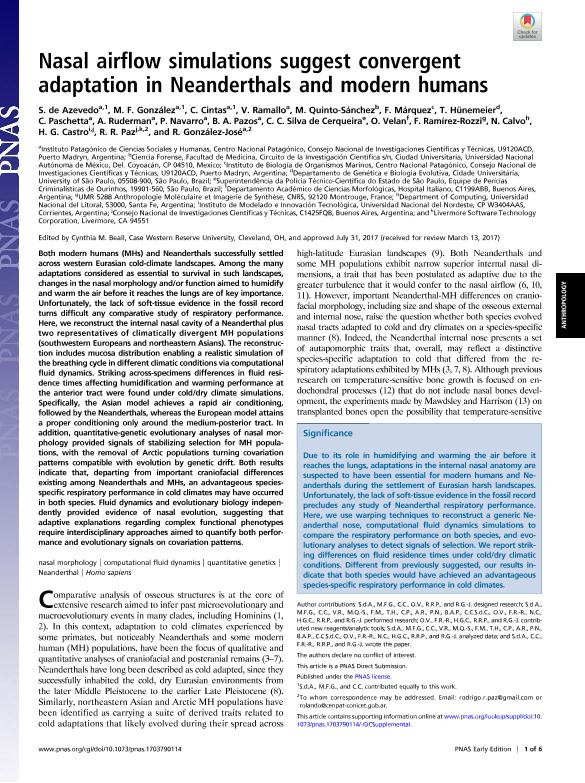Artículo
Nasal airflow simulations suggest convergent adaptation in Neanderthals and modern humans
de Azevedo, Soledad ; González, M. F.; Cintas, Celia
; González, M. F.; Cintas, Celia ; Ramallo, Virginia
; Ramallo, Virginia ; Quinto Sanchez, Mirsha Emmanuel
; Quinto Sanchez, Mirsha Emmanuel ; Marquez, Federico
; Marquez, Federico ; Hünemeier, Tábita; Paschetta, Carolina Andrea
; Hünemeier, Tábita; Paschetta, Carolina Andrea ; Ruderman, Anahí
; Ruderman, Anahí ; Navarro, Jose Pablo
; Navarro, Jose Pablo ; Pazos, Bruno Alfredo
; Pazos, Bruno Alfredo ; Silva de Cerqueira, Caio Cesar
; Silva de Cerqueira, Caio Cesar ; Velan, O.; Ramírez Rozzi, F.; Calvo, N.; Castro, Hugo Guillermo
; Velan, O.; Ramírez Rozzi, F.; Calvo, N.; Castro, Hugo Guillermo ; Paz, Rodrigo Rafael
; Paz, Rodrigo Rafael ; González José, Rolando
; González José, Rolando
 ; González, M. F.; Cintas, Celia
; González, M. F.; Cintas, Celia ; Ramallo, Virginia
; Ramallo, Virginia ; Quinto Sanchez, Mirsha Emmanuel
; Quinto Sanchez, Mirsha Emmanuel ; Marquez, Federico
; Marquez, Federico ; Hünemeier, Tábita; Paschetta, Carolina Andrea
; Hünemeier, Tábita; Paschetta, Carolina Andrea ; Ruderman, Anahí
; Ruderman, Anahí ; Navarro, Jose Pablo
; Navarro, Jose Pablo ; Pazos, Bruno Alfredo
; Pazos, Bruno Alfredo ; Silva de Cerqueira, Caio Cesar
; Silva de Cerqueira, Caio Cesar ; Velan, O.; Ramírez Rozzi, F.; Calvo, N.; Castro, Hugo Guillermo
; Velan, O.; Ramírez Rozzi, F.; Calvo, N.; Castro, Hugo Guillermo ; Paz, Rodrigo Rafael
; Paz, Rodrigo Rafael ; González José, Rolando
; González José, Rolando
Fecha de publicación:
10/2017
Editorial:
National Academy of Sciences
Revista:
Proceedings of the National Academy of Sciences of The United States of America
ISSN:
0027-8424
Idioma:
Inglés
Tipo de recurso:
Artículo publicado
Clasificación temática:
Resumen
Both modern humans (MHs) and Neanderthals successfully settled across western Eurasian cold-climate landscapes. Among the many adaptations considered as essential to survival in such landscapes, changes in the nasal morphology and/or function aimed to humidify and warm the air before it reaches the lungs are of key importance. Unfortunately, the lack of soft-tissue evidence in the fossil record turns difficult any comparative study of respiratory performance. Here, we reconstruct the internal nasal cavity of a Neanderthal plus two representatives of climatically divergent MH populations (southwestern Europeans and northeastern Asians). The reconstruction includes mucosa distribution enabling a realistic simulation of the breathing cycle in different climatic conditions via computational fluid dynamics. Striking across-specimens differences in fluid residence times affecting humidification and warming performance at the anterior tract were found under cold/dry climate simulations. Specifically, the Asian model achieves a rapid air conditioning, followed by the Neanderthals, whereas the European model attains a proper conditioning only around the medium-posterior tract. In addition, quantitative-genetic evolutionary analyses of nasal morphology provided signals of stabilizing selection for MH populations, with the removal of Arctic populations turning covariation patterns compatible with evolution by genetic drift. Both results indicate that, departing from important craniofacial differences existing among Neanderthals and MHs, an advantageous species-specific respiratory performance in cold climates may have occurred in both species. Fluid dynamics and evolutionary biology independently provided evidence of nasal evolution, suggesting that adaptive explanations regarding complex functional phenotypes require interdisciplinary approaches aimed to quantify both performance and evolutionary signals on covariation patterns.
Archivos asociados
Licencia
Identificadores
Colecciones
Articulos(IBIOMAR)
Articulos de INSTITUTO DE BIOLOGIA DE ORGANISMOS MARINOS
Articulos de INSTITUTO DE BIOLOGIA DE ORGANISMOS MARINOS
Articulos(IMIT)
Articulos de INST.DE MODELADO E INNOVACION TECNOLOGICA
Articulos de INST.DE MODELADO E INNOVACION TECNOLOGICA
Articulos(IPCSH)
Articulos de INSTITUTO PATAGONICO DE CIENCIAS SOCIALES Y HUMANAS
Articulos de INSTITUTO PATAGONICO DE CIENCIAS SOCIALES Y HUMANAS
Citación
de Azevedo, Soledad; González, M. F.; Cintas, Celia; Ramallo, Virginia; Quinto Sanchez, Mirsha Emmanuel; et al.; Nasal airflow simulations suggest convergent adaptation in Neanderthals and modern humans; National Academy of Sciences; Proceedings of the National Academy of Sciences of The United States of America; 114; 47; 10-2017; 12442-12447
Compartir
Altmétricas



